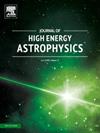Solving an interacting quintessence model with a sound horizon initial condition and its observational constraints
IF 10.5
4区 物理与天体物理
Q1 ASTRONOMY & ASTROPHYSICS
引用次数: 0
Abstract
Astronomical observations suggest that the current standard Λ-Cold Dark Matter model in modern cosmology has some discrepancies when fitting the data during the whole expansion history of the universe. To solve the Hubble constant () tension, usually an unknown mechanism is considered that shifts the sound horizon at the decoupling era. On the other hand, dynamical dark energy models are also considered to resolve the problems of the cosmological constant, and the additional degrees of freedom require initial conditions for a solution. In this article we have considered a coupled quintessence dark energy model with a special focus on its early-time behaviour. In our solution the initial conditions are naturally decided by setting the value of the sound horizon at the recombination time, . We find that during this process, could be derived and its value rises with the coupling strength of the interaction. We also performed the background and cosmic microwave background power spectrum analysis, and find that the existence of the interaction term affects the energy density during a narrow time interval range and shifts the early cosmic microwave background spectrum. We also constrained the parameter space of the underlying scenario using the Markov chain Monte Carlo analysis. We find that the best-fit values of and are improved slightly for the interacting model, but not enough to release the tensions.
具有声视界初始条件的相互作用精粹模型及其观测约束的求解
天文观测表明,现代宇宙学中目前的标准Λ-Cold暗物质模型在拟合整个宇宙膨胀历史中的数据时存在一些差异。为了求解哈勃常数(H0)张力,通常考虑一种未知的机制,使声视界在解耦时代发生位移。另一方面,动力学暗能量模型也被用来解决宇宙学常数问题,而附加的自由度要求解的初始条件。在这篇文章中,我们考虑了一个耦合的典型暗能量模型,特别关注它的早期行为。在我们的解中,初始条件自然是通过设置复合时声视界的值θ θ来决定的。我们发现,在此过程中,可以推导出H0,其值随着相互作用的耦合强度而增大。我们还进行了背景和宇宙微波背景功率谱分析,发现相互作用项的存在在一个狭窄的时间间隔范围内影响能量密度,并使早期宇宙微波背景谱发生偏移。我们还使用马尔可夫链蒙特卡洛分析约束了底层场景的参数空间。我们发现相互作用模型的H0和S8的最佳拟合值略有提高,但不足以释放张力。
本文章由计算机程序翻译,如有差异,请以英文原文为准。
求助全文
约1分钟内获得全文
求助全文
来源期刊

Journal of High Energy Astrophysics
Earth and Planetary Sciences-Space and Planetary Science
CiteScore
9.70
自引率
5.30%
发文量
38
审稿时长
65 days
期刊介绍:
The journal welcomes manuscripts on theoretical models, simulations, and observations of highly energetic astrophysical objects both in our Galaxy and beyond. Among those, black holes at all scales, neutron stars, pulsars and their nebula, binaries, novae and supernovae, their remnants, active galaxies, and clusters are just a few examples. The journal will consider research across the whole electromagnetic spectrum, as well as research using various messengers, such as gravitational waves or neutrinos. Effects of high-energy phenomena on cosmology and star-formation, results from dedicated surveys expanding the knowledge of extreme environments, and astrophysical implications of dark matter are also welcomed topics.
 求助内容:
求助内容: 应助结果提醒方式:
应助结果提醒方式:


